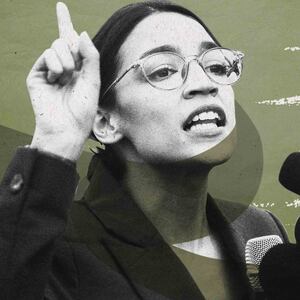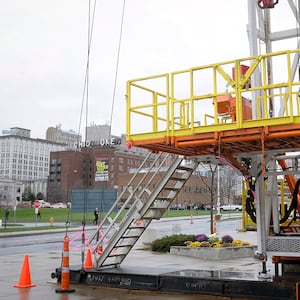There’s a four-way showdown taking place under the waters of New York harbor.
It pits the fracking industry, environmentalists, the Trump administration, and New York Governor Andrew Cuomo against one another. The stakes? In the immediate term, a 23-mile gas pipeline that will connect Pennsylvania’s fracking fields to Long Island’s thirsty energy customers.
More broadly, though, the fight is about whether New York’s progressive upheaval of 2018-19—from the election of Alexandra Ocasio-Cortez, the newly liberal New York State Senate, to the rejection of Amazon’s HQ2 proposal—will extend to climate change and energy policy as well.
ADVERTISEMENT
In other words, New York Harbor could become the Standing Rock of 2019.
“There’s no room for a fracked gas pipeline in a Green New Deal,” Lee Ziesche of the grassroots organization Sane Energy Project told The Daily Beast, referring to Rep. Ocasio-Cortez’s signature initiative.
Such pipelines, Ziesche said, are triply bad, for reasons of climate, leaks, and fracking.
First, pipelines make fracked gas cheaper and thus make a shift to renewable energy—in New York, that mostly means wind and geothermal—comparatively more expensive. “Every bit of fracked gas infrastructure that we build keeps us going in the wrong direction for a very long time,” she said. That makes fracking a net loss for climate change. Moreover, while fracked gas is less climate-damaging than heating oil or coal, pipelines leak so much methane that any savings is more than wiped out.
Second, pipelines leak all the time. “There are two incidents reported every week from gas pipelines. Standing Rock has leaked, Keystone has leaked,” Ziesche said, referring to two of the most bitterly contested pipeline projects of the last several years. “Pipeline companies say they are safe, but there is plenty of evidence that they’re not.” In this case, any leak could threaten New York Harbor, and communities still recovering from Hurricane Sandy.
Third, the proposed pipeline is part of the fracking boom that has ravaged swaths of Pennsylvania, poisoning drinking water and leaking methane. “I’m from Pennsylvania,” Ziesche said. “I know the health impacts of fracking very personally.”
Indeed, New York itself banned fracking in 2014, citing health concerns. “The health commissioner said he wouldn’t want fracking underneath his family home,” Ziesche said, “but we’re saying it’s okay to frack people in Pennsylvania.”
Naturally, Williams, the company proposing the pipeline, has a different point of view.
Chris Stockton, a spokesman for Williams, told The Daily Beast that “natural gas is a critical part of New York’s energy mix and the demand for it continues to increase” and that “Williams is committed to maintaining the highest standards of safely, utilizing construction and operational procedures that exceed already stringent industry regulations.”
The controversy has now hit boiling point.
Last December, the Federal Energy Regulatory Commission, or FERC, approved the project, citing “less than significant environmental impacts.” (FERC is a “rubber stamp for pipelines,” said Ziesche.) However, under Section 401 of the Clean Water Act, New York state must also approve the project. Two public hearings are scheduled this month, with a final decision expected by May 15.
Given that Cuomo has already blocked two pipeline projects, the Constitution Pipeline and the Northern Access Pipeline, it’s quite possible that he might block the Williams Pipeline as well.
But there’s a wildcard: Donald Trump.
The Trump administration has threatened to wipe Section 401 off the books by issuing a series of executive orders that would effectively remove the state permit requirement in the name of national security.
Energy Secretary Rick Perry singled out Governor Cuomo for opprobrium. With the United States in a quest for “energy dominance,” particularly over Russia, Perry said that pipelines are a “national security issue” that trump state “political concerns.”
If Cuomo were to stop the Williams pipeline as well, that could easily be the straw that breaks Perry’s back.
Of course, a more cynical reading of the Trump administration’s posture is that it is yet another gift to the fossil fuel industry, with national security as a fig leaf. One of Trump’s first actions as president was to expedite the construction of the Dakota Access Pipeline, the source of the Standing Rock disputes. That pipeline has leaked several times since it was completed in 2017.
(While Trump and Perry have helped the energy industry by loosening environmental rules and speeding up permits, they’ve crippled pipeline construction because of Trump’s 25 percent tariff on imported steel.)
It is not clear how an executive order could trump a statutory provision written by Congress; it’s entirely possible that Trump might declare another “national emergency” to do so. At the very least, it will be tied up in court for years.
The next move, however, is New York’s.
Simply holding public hearings is a sign that the state takes the controversy seriously. Certainly it doesn’t help the pipeline that it would run just offshore from communities ravaged by Hurricane Sandy; already, activists have created materials featuring Sandy survivors now threatened by a dangerous pipeline, and petitioned signed by thousands of residents opposed to it.
Of course, just as it’s possible to be cynical about the Trump administration’s motivations, some are equally cynical regarding the environmentalists.
Are the photogenic local residents of Far Rockaway (or Pennsylvania) really the motivation for opposition to the pipeline? Or are activists really focused on climate change, with residents (and indigenous people) being used as props, or even pawns?
Ziesche insisted that it’s not a matter of either/or. “In New York City, climate may be the main driver because New York is so vulnerable,” she said. “But it’s really important in the environmental movement that we put affected communities first. These are the people with the most personal impacts from fossil fuels.”
Whatever their motivations, it’s likely that local opposition (and support) will, as with the Amazon HQ2 deal, determine the outcome of the Williams pipeline project. If no one cares about another fracked gas pipeline, the Cuomo administration may choose to sit this controversy out, and greenlight the project in the name of providing energy to Brooklyn and Long Island.
But if opposition continues to mount, the Williams pipeline could be the first test of the ‘Green New Deal’ on the streets of New York City, and under its waters.
Correction: An earlier version of this article referred to Andrew Cuomo as Mario.







